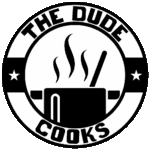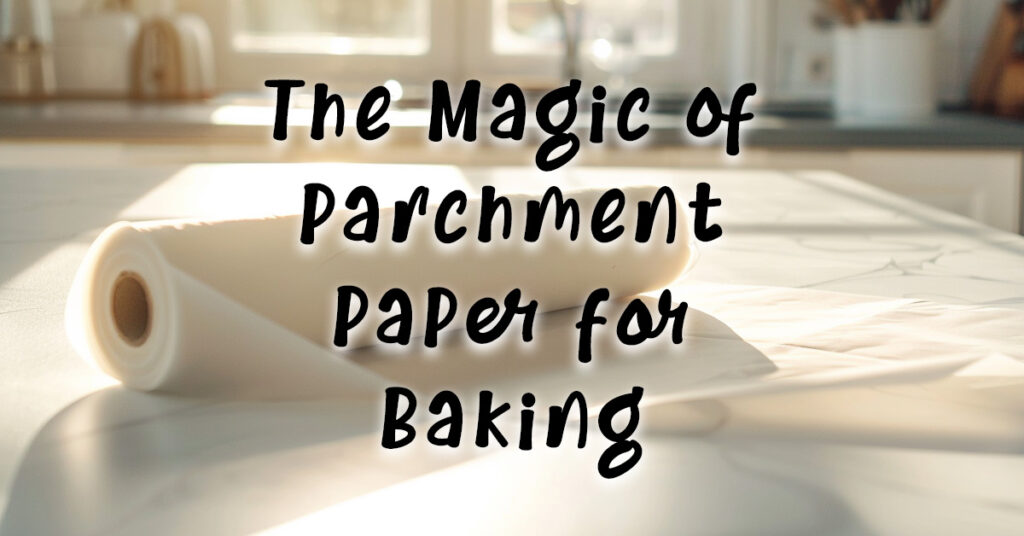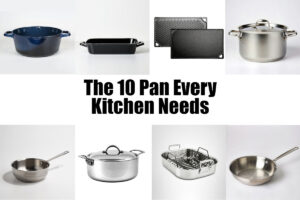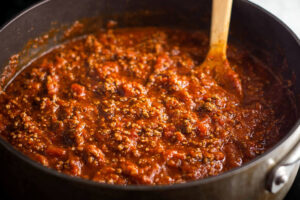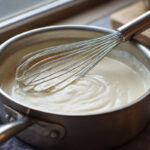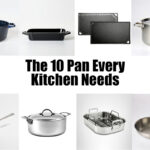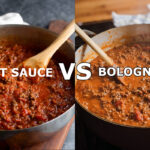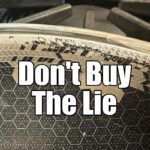Baking is a fun and we love making what we hope will be perfect cakes and cookies. Then we go to turn out the cake and it breaks into pieces. Or we make an awesome baked dinner, then spend two days soaking and scraping the baking dish to get it clean. That really takes the fun out of things.
There is an EASY solution to these problems though. Parchment paper for baking.
I will admit that it took me a long time to come around to using parchment paper not only in my baking but for cooking meals that might get burned onto my pan. In this post I hope to wake you up to how useful parchment paper is for any cook, and how it will save you endless headaches in the kitchen.
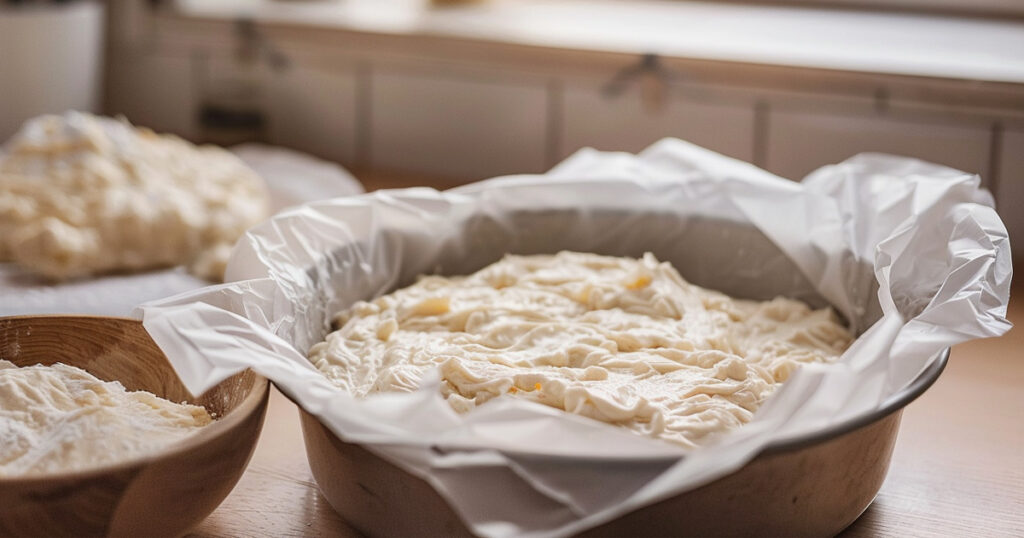
What Is Parchment Paper For Baking?
Parchment paper is a type of paper that has been treated with a thin layer of silicone on both sides. This silicone coating makes the paper nonstick and heat-resistant, making it ideal for use in baking. The silicone creates a barrier between the food and the paper, preventing it from sticking to the surface and ensuring easy release.
Unlike wax paper, which is coated with paraffin wax, parchment paper does not melt or burn at high temperatures. It is also greaseproof, meaning that it will not absorb oil or grease from the food being baked. This makes parchment paper an excellent choice for lining baking sheets or pans, as well as for creating pouches for steaming or baking en papillote. Its nonstick and heat-resistant properties make it a versatile tool for any baker.
Why Use Parchment Paper for Baking?
TLDR: Parchment paper makes baking and cooking easier.
Using parchment paper in baking offers several advantages that can greatly enhance your baking experience. Firstly, parchment paper provides a nonstick surface, making it easier to remove baked goods from the pan without any sticking or tearing. This is particularly useful when working with delicate or sticky doughs, such as really wet bread dough.
Additionally, using parchment paper for baking eliminates the need for greasing baking sheets or pans with nonstick spray or butter. The nonstick properties of the paper ensure that your baked goods will release easily, without leaving any residue behind. This not only saves time and effort but also makes cleanup a breeze, as you can simply discard the parchment paper after use.
Furthermore, parchment paper is heat-resistant and can withstand high temperatures without burning or melting. This makes it suitable for baking at high temperatures, ensuring even browning and preventing the bottoms of your baked goods from burning. With parchment paper, you can achieve perfect results every time and enjoy the convenience of easy cleanup.
What Are All The Uses Of Parchment Paper?
- Lining baking sheets or trays to prevent sticking and simplify cleanup.
- Creating a non-stick surface for baking cookies, pastries, or other baked goods.
- Enveloping foods like fish or vegetables for cooking en papillote (in parchment packets).
- Rolling out dough or pastry to prevent sticking and ease transfer.
- Making homemade piping bags for decorating cakes or pastries.
- Protecting surfaces during messy cooking tasks like chocolate dipping or candy making.
- Separating layers of baked goods to prevent sticking when storing or transporting.
- Wrapping sandwiches, wraps, or burritos for easy handling and transport.
- Covering foods while microwaving to prevent splattering and maintain moisture.
- Forming dividers or barriers in baking pans for layered dishes like lasagna or casseroles.
How To Line A Pan With Parchment Paper Video
There are a lot of ways to line a pan with parchment paper. If you are doing more than using it on a sheet pan, folding parchment paper into a pan can be tricky. Here is a good video on how to line a pan.
Of course, I’m lazy so instead of cutting the corners, I just flip the pan over and fold the paper over the edges to fit, and crimp it so it fits in the pan.
However you do it, you want only about an inch of paper sticking up above the rim of the pan. This reduces the chances of it if falling over into your food, or possibly touching an element in your stove.
Pro-Tip: You may have noticed that in the video, he uses a dab of cooking oil to hold the parchment paper in place. This helps a lot if you didn’t fold it just right and it is wanting to pop out of your pan before you can get your food into it.
Types of Parchment Paper: Bleached vs. Unbleached
There are two main types of parchment paper: bleached and unbleached. Bleached parchment paper is white in color and has been chemically treated to remove the natural color of the paper. This process also makes the paper more dense and smooth, resulting in a higher degree of nonstick properties. Bleached parchment paper is often preferred for baking delicate or light-colored baked goods, as it does not leave any residue or color on the food.
On the other hand, unbleached parchment paper is brown in color and has not undergone any chemical treatment to remove the natural color of the paper. It retains its natural appearance and properties, providing a slightly different texture and nonstick effect. Unbleached parchment paper is often favored for baking darker and more robust baked goods, such as breads or roasted vegetables.
Both bleached and unbleached parchment paper are equally effective in preventing food from sticking and ensuring easy release. The choice between the two depends on personal preference and the specific baking project at hand.
Can Parchment Paper Go in the Microwave?
Yes, parchment paper can be used in the microwave. However, it is important to use caution and follow the manufacturer’s instructions. Parchment paper is heat-resistant and greaseproof, making it suitable for reheating or cooking food in the microwave. It helps to keep food moist and prevents it from sticking to the microwave-safe dish.
Can You Use Parchment Paper In An Air Fryer?
When it comes to using parchment paper in an air fryer, there are a few things to consider. While parchment paper is safe for use in the microwave and conventional ovens, it may not be the best option for air frying. The high heat and circulating air in an air fryer can cause parchment paper to fly around or even catch fire.
Instead of parchment paper, consider using perforated parchment paper liners or aluminum foil with holes punched in it to allow proper air circulation while still preventing food from sticking. These alternatives can help you achieve crispy results without compromising safety in your air fryer cooking.
Can I Use Parchment Paper for Grilling?
While parchment paper is heat-resistant, it is not recommended for use directly on a grill. The high temperatures and open flames can cause the parchment paper to burn or catch fire. Instead, use a nonstick spray or oil the grill grates before grilling to prevent food from sticking.
Will Parchment Paper Burn Under A Broiler?
Yes, parchment paper can burn under a broiler. Broiling involves exposing food to high heat from above, which can quickly cause parchment paper to ignite or char. Therefore, it’s generally not recommended to use parchment paper under a broiler.
If you want to keep you pans clean under a broiler, then you want to be using good old aluminum foil.
Parchment Paper vs. Silicone Mats
When deciding between silicone baking mats and parchment paper, consider their differences. Silicone mats are reusable and eco-friendly, ideal for frequent bakers. In contrast, parchment paper offers convenience for single-use applications and easy cleanup. Silicone mats provide even heat distribution and prevent sticking, while parchment paper is versatile and suitable for various baking needs. Both options have their advantages, so choose based on your baking preferences and environmental considerations.
When it comes to choosing the right baking surface, parchment paper is not the only option. Here’s a comparison of parchment paper with other commonly used baking surfaces:
| Feature | Silicone Baking Mats | Parchment Paper |
| Nonstick Surface | Yes | Yes |
| Heat Resistance | Up to 480°F (250°C) | Up to 425°F (218°C) |
| Reusable | Yes | Yes |
| Cleanup | Easy cleanup, dishwasher safe | Easy cleanup, disposable or reusable depending on use |
| Durability | Durable and long-lasting | Disposable after several uses |
| Versatility | Can be used for baking, roasting, and freezing | Primarily used for baking and lining baking pans |
Parchment Paper or Silicone Mats For Cookies?
For me, I use parchment paper for pans with sides, like brownie pans, cake pans, and so on. For cookie sheets, I prefer a silicone mat. In my experience the silicone baking mats like the ones in the photo below, prevent the bottoms from burning better than parchment paper, and hold on to the pans better, so my cookies don’t all head for the floor at once.
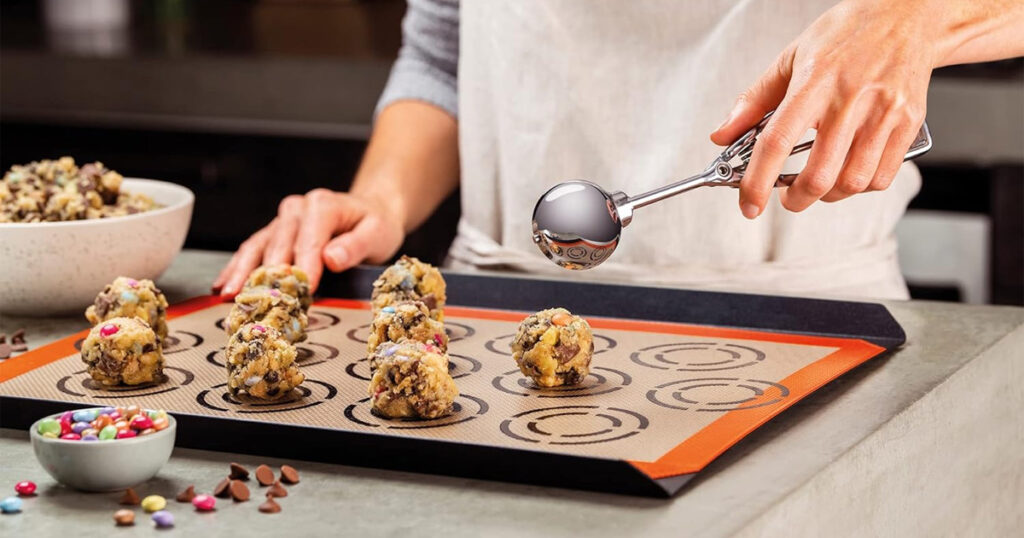
Parchment Paper vs Non-stick Spray
When comparing parchment paper to non-stick spray in baking, both have their merits, but parchment paper often comes out on top for its versatility and convenience. While non-stick spray can also prevent sticking, parchment paper offers additional benefits such as providing a clean surface for baking without the need for extra greasing. The nonstick properties of parchment paper make it a reliable choice for ensuring that your baked goods release effortlessly, while also simplifying cleanup afterward. Additionally, parchment paper’s heat-resistant nature allows it to be used at high temperatures without compromising its integrity, making it a reliable option for various baking needs
Parchment Paper vs Wax Paper
When comparing parchment paper to wax paper for baking, it’s important to note their distinct differences in terms of heat resistance and purpose. Parchment paper is heat-resistant up to 480°F (250°C) and is suitable for baking, roasting, and freezing due to its nonstick properties. On the other hand, wax paper is riskier to use in the oven as it can melt or catch fire. Wax paper is primarily used for wrapping food or lining surfaces for tasks that do not involve high temperatures, such as separating layers of baked goods or storing items in the refrigerator
Parchment Paper vs Aluminum Foil
When comparing parchment paper to aluminum foil for baking, both serve different purposes in the kitchen. Parchment paper is ideal for its nonstick properties and heat resistance, making it perfect for lining baking sheets and pans without the need for additional greasing. On the other hand, aluminum foil is better suited for wrapping or covering food during cooking to retain moisture and heat. While both are versatile kitchen essentials, parchment paper is the go-to choice for baking enthusiasts looking for easy cleanup and reliable nonstick results.
Other Uses For Parchment Paper
People mostly think of using parchment paper for baking to line baking pans for cakes and cookies, but there are a lot of other uses that I don’t want you to miss.
Parchment Paper Brownies
One excellent baking use for parchment paper is brownies. Brownies always want to stick to the pan. Lining your brownie pan with parchment paper means that you can pull hot brownies out of the pan and cut them up into squares.
Level Up Your Brownies With This Brownie Cutter On Amazon
Steaming Food In Parchment Paper
Steaming food in parchment paper packets is a simple yet elegant cooking technique that yields delicious and healthy results. Whether you’re cooking a light and flavorful fish dish or a vibrant assortment of seasonal vegetables, en papillote is sure to impress your family and friends with its beautiful presentation and mouthwatering flavors. So grab some parchment paper, gather your favorite ingredients, and get ready to experience the magic of steaming en papillote!
Cooking Bacon On Parchment Paper
Love to cook bacon, but hate to deal with the cleanup? Line a baking pan with parchment paper, lay out your bacon and pop it in your oven. When you are done, let your pan cool and either toss the paper and bacon grease (heresy!) or save the bacon grease for cooking later.
Reusing Parchment Paper
Something not everyone knows is that as long as it isn’t burned, you can use reuse parchment paper for baking. Now this isn’t always practical, if you you used it for something like cooking bacon for example, but if you just baked a few cookies on it, there is probably some life left in your parchment paper.
Best Practices for Cleaning Used Parchment Paper
After you have used your parchment paper for baking, let it cool down a little, then wipe it clean. Ultimately it is paper and so if you get too aggressive with it, you can clean it to death.
How Many Times Can You Reuse Parchment Paper?
The number of times parchment paper can be reused depends on its condition and the type of food it was used with. If the parchment paper is lightly soiled and in good condition, it can be reused multiple times before discarding. However, if the parchment paper is heavily soiled, torn, or burnt, it is best to dispose of it and use a fresh sheet. Reusing parchment paper is a great way to reduce waste and minimize the environmental impact of baking.
The most common place to reuse parchment paper is when you are baking cookies since the paper stays nice and flat.
Is Parchment Paper Environmentally Friendly?
Parchment paper is considered to be more environmentally friendly compared to other alternatives such as aluminum foil or wax paper. It is made from natural materials and can be recycled in some areas. However, it is important to check with your local recycling facilities to ensure proper recycling. Additionally, look for parchment paper that is responsibly sourced and packaged in eco-friendly or recyclable materials to further promote sustainability.
When Not To Use Parchment Paper
Avoid using parchment paper in extremely high temperatures or under a broiler as it can ignite.
When baking delicate items that need direct heat conduction, like cookies or biscuits, parchment paper may hinder browning. Additionally, avoid using parchment paper when a recipe specifically calls for greasing and flouring the pan for proper texture development or when using it for tasks that require a nonstick surface, as parchment paper doesn’t offer the same qualities as a greased pan. Remember, parchment paper has its best uses but may not always be the ideal choice.
At What Temperature Does Parchment Paper Burn?
Parchment paper is generally safe to use in the oven up to temperatures of about 420°F to 450°F (215°C to 232°C). Beyond this range, parchment paper can start to brown, smoke, and eventually burn. It’s important to avoid exposing parchment paper to direct flames or the heating elements in an oven or broiler, as this can cause it to ignite.
Where Is The Best Place To Buy Parchment Paper?
Typically I’ve always bought my parchment paper at the grocery store or restaurant supply store. Likely I’m overpaying. You can find precut parchment paper sheets, or rolls of it online for much cheaper than what is at your local store.
At the store, 36′ of 15″ wide parchment paper is $5.49 or $0.15/lf. Jumping on Amazon, I can find a 200′ long roll for $14.99 or $0.07/lf. If you have the time to order ahead, it is much cheaper to buy a roll of parchment paper on Amazon.
Conclusion
In conclusion, mastering the art of baking with parchment paper can elevate your culinary skills to new heights. From understanding its uses to avoiding common mistakes, this guide provides a comprehensive overview for both beginners and advanced bakers. Whether you’re creating intricate decorations using a piping bag or ensuring even heat distribution for perfectly baked goods, parchment paper is a versatile tool in the kitchen. Remember to follow best practices for cleaning and storage to prolong its usability. So, grab your parchment paper and get ready to bake with confidence and precision!
